Get the latest announcements and updates from The Epoch Times. Stay informed on our latest events, offers, and more. Visit us now.
Dear readers,
The Epoch Times website over the past several days has experienced large-scale cyberattacks from the Chinese communist regime.
The source of these attacks was confirmed to The Epoch Times by a government intelligence agency.
The Chinese Communist Party (CCP) over the years has launched many cyberattacks against The Epoch Times in its attempts to silence our truthful reporting. While many Western media organizations have appeased the CCP, The Epoch Times has consistently exposed it.
As a result of these attacks, some readers might have trouble opening the website or have a slower than usual website experience. Our tech teams are currently working to resolve these issues. No personal information has been accessed.
We thank you for your support as a subscriber; attacks like these only strengthen our resolve to deliver the truth.
A good night’s rest does more than just give you beauty sleep. New research suggests your sleep patterns could be linked to serious underlying health issues.
Adults suffering from chronic insomnia for at least a decade face significantly higher risks of developing conditions like heart disease, diabetes, and depression, according to the results.
However, the news isn’t all bad—the study also found that adults who make up for lost sleep on the weekends by taking naps are not at an increased risk for these underlying health problems.
More Than Half of Americans Exhibit Problematic Sleep HabitsThe study, published in Psychosomatic Medicine, analyzed data from the Midlife in the United States (MIDUS), a national sample of continental U.S. residents between 25 and 74 years of age. The dataset included information on the sleep habits and chronic health conditions of approximately 3,700 individuals collected from 2004 to 2006 and from 2013 to 2017.
Four distinct sleep patterns were identified:
Good sleepers: People with “optimal sleep health across all dimensions” Insomnia sleepers: People suffering from clinical insomnia, including short sleep duration, high daytime exhaustion, and difficulty falling asleep Weekend catch-up sleepers: Those who may have irregular or shorter sleep during the week but longer sleep times on weekends or non-work days Nappers: Those who typically slept well but took frequent daytime napsMore than half of the participants were either insomnia sleepers or nappers, both of which are considered sub-optimal sleep patterns.
The data revealed that people with chronic insomnia were 72-188 percent more likely to develop cardiovascular disease, diabetes, depression, and frailty compared to good sleepers. Overall, being an insomnia sleeper increased a person’s risk of a chronic condition by 28-81 percent.
The study found that “being a napper at any timepoint” was related to increased risks for diabetes, cancer and frailty.
The researchers also noted that those with lower education and those who were unemployed were more likely to be insomnia sleepers, while older adults and retirees were more likely to be nappers.
Sleep Patterns Proven Difficult to ChangeThe study also found that sleep patterns tend to be remarkably resistant to change.
Overall, 77 percent of participants remained in the same sleep pattern, or “phenotype,” over the study period. More specifically, 90 percent of insomnia sleepers and 97 percent of nappers maintained those same habits throughout the study. Those categorized as weekend catch-up sleepers were more likely to transition into being nappers.
“These results may suggest that it is very difficult to change our sleep habits because sleep health is embedded into our overall lifestyle,” Soomi Lee, associate professor of human development and family studies at Penn State and the lead researcher, said in a press release. “It may also suggest that people still don’t know about the importance of their sleep and about sleep health behaviors.”
Despite the apparent rigidity of sleep patterns, education and consistent practice can help facilitate positive changes over time, according to Mr. Lee.
He recommends that public health efforts focus on educating people about proper sleep hygiene. The U.S. Centers for Disease Control and Prevention recommends five key tips:
Maintain consistency by going to bed at the same time each night. Create a sleep-conducive environment—dark, cool, and quiet. Remove electronic devices from the bedroom. Avoid large meals, caffeine, and alcohol close to bedtime. Get enough physical activity during the day to support better sleep at night.A few studies have identified an association between frequent sauna use and lower sperm quality.
But are these effects permanent? And do the potential benefits of sauna use outweigh any risks?
The Potential Risks of Sauna UseOne study, led by Dr. Andrea Garolla, a reproductive medicine specialist, found that participants who used saunas regularly over three months demonstrated reduced sperm counts and impaired sperm motility. However, these effects were reversed six months after the participants stopped using the sauna. It’s also important to note that this was a small study with only 10 participants.
Andrew Huberman, a neuroscience professor at Stanford University who regularly discusses the use of saunas on his popular podcast, has noted both the pros and cons of heat exposure. He has discussed the many ways in which deliberate heat exposure can improve mood levels, adjust hormone levels, and aid both athletic performance and recovery. On the flip side, he has also warned men, especially those trying to conceive, that “repeated deliberate heat exposure can reduce sperm count.” Although sperm counts can rebound after cessation of sauna use, he emphasized that rebounds may not occur for as many as 60 days.
Giresh Kanji, a musculoskeletal pain specialist based in New Zealand, has been researching the effects of saunas for over a decade. When asked about heat exposure and a decrease in sperm quality, Mr. Kanji said that he was unaware of any robust studies indicating side effects for males who use saunas. On the contrary, he says, “The research is overwhelmingly positive.”
Outweighing the Risks: Experiencing Sauna BenefitsDr. Jari Laukkanen, a cardiologist at the University of Eastern Finland, believes that the benefits of sauna use for both men and women far outweigh any potential costs. He told The Epoch Times that “several studies,” including one of his own, “suggest that regular (around 20 to 30 minutes per session) sauna bathing reduces the risk of hypertension, cardiovascular diseases, sudden cardiac death, stroke, and dementia.” When asked for his thoughts on the reported adverse effects on men’s sperm quality, Dr. Laukkanen said, “Based on available limited evidence, there are no negative, long-term effects.” Moreover, “Those effects are not negative for sexual function or reproduction.”
Hormone ChangesDr. Laukkanen referenced a 2020 paper that he co-authored with Ilpo T. Huhtaniemi, a member of Imperial College London’s Institute of Reproductive and Developmental Biology, in which they found sauna bathing brought about numerous acute changes in hormone levels. These included a significant increase in norepinephrine, a chemical messenger and hormone that plays a key role in our movements, many bodily functions, and our mood, thoughts, and hunger levels. It also aids in memory retrieval and improving pain tolerance.
Additionally, the sweating caused by sauna bathing increases the production of anti-diuretic hormone, otherwise known as vasopressin, which helps maintain body fluid balance. The researchers also pointed out that regularly using a sauna is not associated with a reduction in fertility, despite decreasing sperm production for some men and disrupting the menstrual cycle for some women.
Less PainPain and inflammation can negatively affect a person’s ability to complete everyday tasks, but sauna use may be able to reduce persistent symptoms for some people.
In particular, studies have shown that regular sauna use helps those suffering from rheumatoid arthritis and lower back pain. In the United States, according to researchers at Georgetown University, 8 percent of all adults—roughly 16 million people—experience chronic back pain. More than 1 million people are affected by rheumatoid arthritis.
Stress ReliefMr. Kanji told The Epoch Times that saunas are beneficial for alleviating stress. “Stress,” according to him, “can be described as a condition in which the sympathetic nervous system tone is elevated and the parasympathetic tone is reduced.”
At chronic levels, he added, this leads to insomnia, anxiety, depression, psychosis, anger, irritability, “as well as many long-term consequences such as dementia, heart disease, and reduced immune function.”
His research has found that five habits for improving “autonomic dysfunction” include the use of saunas, regular cardiovascular exercise, yoga, tai chi, and meditation. “Sauna bathing,” Mr. Kanji noted, “is the most effective habit of all regular habits to help stress symptoms.” For most Americans, it seems, chronic stress is an unwanted but natural part of their everyday existence.
Studies, added Mr. Kanji, “show sharp improvements in nervous system functioning after four weeks of sauna bathing.”
Better SleepStudies have also shown that sauna usage can positively impact sleep. This has been the case for Mr. Kanji, who says saunas occupy a special place in his life.
Before the age of 15, he had four incredibly serious hospitalizations. Traumatized by two sibling deaths and poverty, Mr. Kanji shared that he suffered from both nightmares and night sweats three or four days a week until he was around 40.
He then opted to pursue a doctorate, full-time for five years, focused on stress and pain. “This,” he suggested, “is where I made the connection between pain and stress and the benefits of heat. Attending the sauna regularly has been far more effective than exercise for me in improving my sleep, which is excellent.” Moreover, for the best part of 10 years, he has not experienced any nightmares or night sweats.
When asked how often he uses a sauna, Mr. Kanji said he attends five days per week for 20 minutes at a time.
Optimal Sauna UseSaunas vary in temperature, often ranging from 113 F to 212 F (45 C to 100 C).
As for optimal temperatures when using a sauna, Mr. Kanji emphasized that not all saunas are created equally. For example, Swedish saunas can go to 80 C (176 F). “Ideally,” he says if using a Swedish sauna, “60 to 70 degrees Celsius is the most comfortable.” However, he concluded, “Infrared saunas can start at 40 degrees and still have the desired effect.”
Dr. Garolla’s study, which saw impaired sperm count and motility, had participants use the sauna at 80 C to 90 C. “Men wishing to avoid sperm count reductions due to heat,” according to Mr. Huberman, “may opt to apply a cool or cold pack while in the sauna.”
With proper precautions, sauna users can reduce the potential for adverse side effects and experience the multiple benefits of exposing one’s body to appropriate temperatures.
Three top housing groups call on Federal Reserve Chair Jerome Powell to stop increasing interest rates as the industry struggles with “a historic shortage of attainable housing.”
In a letter dated Oct. 9, the Mortgage Bankers Association, the National Association of Realtors, and the National Association of Home Builders expressed “a profound concern” with the central bank that “that ongoing market uncertainty about the Fed’s rate path is contributing to recent interest rate hikes and volatility.”
The move comes as the Federal Reserve has increased interest rates 11 times since March 2022 in an effort to combat inflation.
The groups pointed out that the rate hikes pushed by the Fed “has exacerbated housing affordability and created additional disruptions for a real estate market that is already straining to adjust to a dramatic pullback in both mortgage origination and home sale volume. These market challenges occur amidst a historic shortage of attainable housing.”
They cited data saying that mortgage rates reached 23-year highs, dragging down housing market activity “and resulting dislocation in our industry is painful and unprecedented in the absence of larger economic turmoil.”
The groups also blamed increasing shelter costs as a source of high inflation. In September, shelter costs, which include rent and mortgage payments, were the largest contributor to the Consumer Price Index (CPI), climbing 0.6 percent monthly and 7.2 percent from a year ago.
The groups warned that further interest hikes will “pose broader risks to economic growth, heightening the likelihood and magnitude of a recession.”
They called on the Fed not to “contemplate further rate hikes” and not to sell its holdings of mortgage-backed securities until “the housing market has stabilized.”
“We urge the Fed to take these simple steps to ensure that this sector does not precipitate the hard landing the Fed has tried so hard to avoid,” the group said.
The Fed said to The Epoch Times that they have no comment on the matter.
Mortgage Rates Reach Historical HighHousing costs have soared this year as the average monthly mortgage payment and rent are above $2,000. Experts warn that this has resulted from an undersupplied market and higher interest rates.
The housing market has been severely affected since the Fed started raising the interest-rate campaign from near zero percent in March 2022 to 5.25 percent to tame high inflation.
Fed’s policy pushed other rates higher, particularly the 10-year Treasury yield, which is closely tied to the mortgage rates.
According to Freddie Mac, the mortgage rates have increased to 7.57 percent, a 23-year high.
As a result, many homebuyers are reluctant to buy houses due to higher borrowing costs, while multiple current homeowners are refraining from selling their residential properties because they do not want to lose their current low mortgage rates secured during the coronavirus pandemic. This leads to fewer housing transactions, hurting real estate brokers and agents.
After recent rate hikes for five weeks in a row, Freddie Mac on Oct. 12 warned that “the housing market remains fraught with significant affordability constraints. As a result, purchase demand remains at a three-decade low.”
Increase or Pause?After increasing interest rates by over five percentage points during the last 19 months, the Fed now considers whether it will keep raising the benchmark lending rate again. In the last meeting in September, they kept the rates unchanged.
For now, the futures market is mostly pricing in a rate pause at the policy-setting meetings in November and December of the Federal Open Market Committee (FOMC), according to the CME FedWatch Tool.
A handful of Fed officials have suggested that interest rates are high enough and that even the recent rally in Treasury yields could help do some of the U.S. central bank’s work.
Minutes from the September FOMC meeting suggest that officials debated whether to pull the trigger on one more rate increase. As committee members discussed the need for additional policy tightening, there was one uniform opinion: Rates would need to remain in restrictive territory until the Federal Reserve was confident that inflation is sustainably returning to its 2 percent target level.
“A majority of participants judged that one more increase in the target federal funds rate at a future meeting would likely be appropriate, while some judged it likely that no further increases would be warranted,” the minutes read.
While policymakers agreed that they need to “proceed carefully” on future decisions, they concurred that “policy should remain restrictive for some time until the committee is confident that inflation is moving down sustainably toward its objective.”
Andrew Morgan and Tom Ozimek contributed to this report.
Travellers might need to brace for soaring airfare costs as airlines attempt to cut their emissions simultaneously while the demand for travel increases.
This follows the federal government’s updated safeguard mechanism—which came into effect in July—that has set limits on the greenhouse gases from Australian companies to reduce emissions to 43 percent below 2005 levels by 2030 and net zero by 2050.
But airline bosses have said this change will come at a price.
Virgin Australia’s Chief of Corporate Affairs, Christian Bennett, said sustainable aviation fuel was the answer for dramatically cutting emissions.
But he noted that fuel was up to five times more expensive than the currently used jet fuels.
Lack of Seats Curbing DemandThe comments come as the head of Sydney Airport warns a lack of seats is restraining domestic flight options rather than a lack of demand.
Sydney Aiport has said the lack of seats is due to the airlines “hoarding” take-off and landing slots.
Chief Executive Geoff Culbert said domestic passenger numbers had remained stagnant over the past 15 months. However, he noted that international traffic was seeing growth.

This is the first time since COVID-19 travel restrictions eased that the recovery in international traffic had overtaken the domestic travel recovery at the country’s busiest airport as of July.
Mr. Culbert accused major airlines of effectively stockpiling spaces at the airport, which other providers could utilise to boost their capacity and diminish costs.
“We continue to see evidence of unused slots going to waste, with a persistent mismatch between slots held by domestic airlines and the schedule that is flown,” he said.
Mr. Culbert said a surge of passengers from China, Korea, and India had been encouraging, but lagging markets like the U.S. and New Zealand and domestic travel offset it.
“The (domestic) lag is being driven by a lack of seat capacity rather than a lack of demand,” he said.
But Mr. Bennett said Virgin Australia was “fully aligned with the safeguard mechanism’s goals” despite its potential to add to the price of airfares.
“There is no escaping the challenge of sustainable aviation fuel,” he said during a parliamentary hearing on Monday.
“The technology is not the problem—actually making sustainable aviation fuel is not the problem.”

“Economics is the problem,” he said.
The airline must reduce emissions by 4.9 percent to align with pollution limits.
Mr. Bennett said sustainable jet fuel was the “slingshot” to net zero because it produced 80 percent less pollution than conventional options.
But environmentally friendly fuel is two to five times more costly than commercial jet fuel as it is not produced in Australia, with Mr. Bennet explaining that Virgin’s single largest expense and a quarter of its operating costs is fuel.
The raw material used to produce sustainable fuel has increasingly been shipped to the U.S. and Singapore. But he noted that domestic fuel production from Australian feedstocks could pull down prices and emissions at the same time.
Currently, the company has begun using blends of conventional and greener fuels to reduce emissions.
Sustainable Aviation ReportAnd more than 600,000 flights between Sydney and Melbourne could be powered by fuel made from agricultural waste in 2025, a Sustainable Aviation Fuel Roadmap report found.
But the Australian industry and governments must make changes to support sustainable aviation fuel.
With more significant investments, aviation emissions could be significantly cut as a biofuel could also power 90 percent of all domestic flights by 2050.
CSIRO senior manager and report author Max Temminghoff said Australia was uniquely placed to meet the growing demand for sustainable aviation fuel (SAF) because of its strong agricultural industry.
Aviation biofuel can be created using waste from farming, such as sugarcane, sawmill residue, sorghum, used cooking oil, canola and cottonseed.
“Australia had enough feedstock that, if refined locally, could create 60 percent of jet fuel needed for domestic flights in 2025 and 90 percent of the fuel needed in 2050,” Mr. Temminghoff said.
He said the road map estimates Australia is “currently sitting on enough resources to produce almost five billion litres of SAF by 2025.”
“That’s enough fuel to power 640,000 Melbourne to Sydney return flights on a Boeing 737,” he said.
The report also found that a biofuel industry could generate jobs and export opportunities in Australia, though it also cautioned that the industry would need more investment and research to reach its potential.
Worldwide, the aviation industry has pledged to achieve net-zero emissions by 2050.
Qantas has committed to using 10 percent biofuel to cut carbon emissions by 25 percent in 2030, and Virgin Australia recently tested a flight using a 30 percent sustainable fuel blend.
AAP contributed to this article.
Qantas has been hit with a class action lawsuit seeking millions of dollars in refunds and compensation for customers who had flights cancelled after the COVID-19 outbreak.
Echo Law filed the lawsuit against Australia’s national carrier in the Federal Court last Monday. They are alleging that the airline misled customers about their refund options, withheld funds, and engaged in a “pattern of unconscionable conduct.”
The airline has rejected this and said it refunded more than $1 billion to customers impacted by flight disruptions in 2020—the first year of the coronavirus pandemic, which sparked lengthy border closures.
The action comes one month after Qantas launched a campaign to encourage customers to use the airline’s remaining $400 million in flight credits and after Australia’s consumer watchdog indicated its probe into the issue was almost complete.
Backed by litigation funder CASL, the lawsuit alleges Qantas breached Australia Consumer Law by failing to immediately issue refunds when flights were cancelled in 2020 and by retaining customers’ funds.
Echo Law partner Andrew Paull said Qantas initially only offered customers access to “travel credits with strict conditions” rather than returning their payments.
“We allege Qantas breached the law by failing to be transparent and immediately issue refunds to customers when flights were cancelled,” he said.
“While COVID posed major disruption to air travel and resulted in cancellations that no airline wished to make, that is no excuse for Qantas to take advantage of its own customers and effectively treat them as providers of over $1 billion in interest-free loans,” he said.
Mr Paull claimed some Qantas customers had been forced to spend more money with the airline to use their original flight credits, while others may not be able to use the credit before it expired on December 31, 2023.”
“While Qantas has talked in recent weeks of giving customers the option of requesting a refund, this is both too little and too late,” he said.
Mr Paull said “that money ought to have been automatically returned to customers, in most cases more than three years ago, and we are seeking both refunds of all remaining credits as well as compensation for the time customers have been out of pocket.”
Qantas Credits System Among Worlds Most FlexibleQantas extended the expiry date on travel credits issued in 2020 three times and, in July, launched a campaign for customers to find and use flight credits from 2020.
Qantas said its flight credit policies were among the most flexible in the world, and it had improved its system to simplify the refund process.
The airline said it held about $400 million in COVID-era credits, and more than $1 billion had been claimed by Qantas and Jetstar customers.
“We have already processed well in excess of $1 billion in refunds from COVID credits for customers who were impacted by lockdowns and border closures,” Qantas said.
“The majority of customers with COVID credits can get a refund, and we’ve been running full-page ads and sending emails to encourage customers who want a refund to contact us directly.”
Qantas chief customer officer Markus Svensson said many travel credits were for between $100 and $500 and could be located online.
“We’ll keep reaching out directly to customers, particularly ahead of these credits expiring at the end of this year,” he said.
Regulation and governance associate professor Rob Nicholls said the opportunity from Qantas travel credits was limited.
Mr Nicholls said the national carrier should “extend the life of those credits” to restore balance for consumers.
“There is some element of choice for Qantas management and the Qantas board here, and exercising that choice could stifle the class action lawsuit,” he said.
On Monday, Qantas announced plans to add more than 250,000 seats on its international network to destinations including New York, Los Angeles, Johannesburg and Bali.
The carrier said the boost would bring its capacity to 80 per cent of its pre-pandemic service.
The Australian Competition and Consumer Commission is investigating Qantas’ handling of credits and refunds after issuing a warning to the airline in 2020 and receiving a complaint from consumer group Choice in April 2022.
In late March, Italy became one of the first countries to take a decisive stance on lab-grown meat. The proposed bill is clear: Italy seeks to ban lab-grown meat production, sale, and use.
If the bill is passed in Parliament, a violation of the law could result in a $65,000 fine.
Francesco Lollobrigida, Italy’s Minister for Agriculture and Food Sovereignty, said lab-grown foods “do not guarantee quality, well-being, and the protection of our culture, our tradition.”
The bill marks an unequivocal concern about lab-grown meat’s uncertainties and potential dangers. In contrast, the U.S. Food and Drug Administration approved the use of lab-grown meat in November 2022.
What Is Lab-Grown Meat?Akin to the push to create various versions of plant-based meat, scientists have been propelled to develop lab-grown meat to provide an alternative to conventionally raised meat.
To create meat, scientists combine animal cells from live animals with various nutrients like amino acids and carbohydrates. Then, under the right conditions, the cells replicate and produce “cultured meat.”
While this process sounds as straightforward as whipping up your favorite cookie recipe, producing lab-grown meat requires cutting-edge technology and exceptional scientific precision.
Dr. Greg Potter, a bioprocess and fermentation scientist, explained that the process could be compared to the technically demanding production of vaccines. “In cultured meat production, you need to grow large quantities of cells from terrestrial animals or seafood species in bioreactors, and the same thing is done in vaccine production,” he told The Epoch Times.
Dozens of food companies and biotech firms have invested billions into the research and development of lab-grown meat. So far, this ostensibly far-fetched idea of growing meat in a lab has been “proven by numerous groups around the world in the laboratory,” Potter said.
However, the feasibility of producing lab-grown meat to scale summons a significant challenge. “The growth media currently used has expensive inputs that need to be replaced with more economical options for commercial-scale production,” Potter explained.
According to one report, one kilogram of lab-grown meat is estimated to cost $8,500 to $36,000. In comparison, one kilogram of wholesale chicken costs $3.11 per kilogram.
Though this price comparison is beyond significant, for many food companies and financiers, lab-grown meat is still considered the future of food.
The Nutritional Shortcomings and Unknown RisksProponents of lab-grown meat believe it provides an equal alternative to conventionally raised meat. However, researchers have yet to create a form of lab-grown meat that contains the numerous essential nutrients that conventionally raised meat provides.
“Meat is so complex you can never create the equivalence,” said Dr. Joseph Mercola, a functional health care doctor and nutrition expert.
“Even if you add synthetic vitamins to the matrix, there is no possibility of creating nutritional equivalence,” he said.
With 92 percent of Americans facing some sort of nutritional deficiency, replacing current versions of meat containing essential nutrients with lab-grown versions would fail to resolve the nutritional deficit.
According to Mercola, science and technology aren’t the route to secure nutrition.
“Most people realize that ancestral, organically grown whole foods and meats are the most desirable for optimal health and longevity,” he said.
In addition, research regarding lab-grown meat’s influence on health is lacking. Zero studies have examined how consuming lab-grown meat could alter our health.
But lab-grown meat companies’ primary marketing tools seem to be based less on nutritional values and more built on the ethical and environmental issues surrounding meat eating.
The Ethical Argument for Lab-Grown MeatThe Humane League, an animal rights organization, promotes that lab-grown meat “could hold the key” to fixing the “broken food system.” They contend that “no animals would need to be bred, confined, or slaughtered to create these real meat products.”
However, this assertion lacks the whole truth regarding the production of lab-grown meat.
For instance, fetal bovine blood is used to produce many types of lab-grown meats. When producers do not use fetal bovine blood, animals are still essential to create lab-grown meat. Though to a lesser extent than conventionally raised meat, breeding and confinement are also necessary.
Is Lab-Grown Meat Sustainable?Pioneers of the movement attest that switching to lab-grown meat will mitigate the environmental impact of the meat industry. Companies such as Good Meat—whose lab-grown chicken was recently approved by the FDA—maintain that they provide meat without “tearing down a forest or taking a life.”
To restore our environment, companies like Good Meat say lab-grown meat is the answer, and that it’s the more sustainable option.
These claims, however, are estimated by data that aren’t yet fully known. While some data point to lab-grown meat production emitting fewer greenhouse gases than conventional livestock farming, as one report notes, these findings come with “high uncertainty.”
Diana Rodgers, a dietician and executive director of the Global Food Justice Alliance, expressed that lab-grown meat “is a high-energy process that uses vast amounts of mono-crop agriculture, which is chemically intensive,” she said in an interview with The Epoch Times.
Given that mono-crop agriculture relies on environmentally harmful pesticides and herbicides, some researchers contend that it is the driving force behind the changing nature of our environment.
“I don’t see how this [lab-grown meat] is better from a sustainability perspective as opposed to educating more farmers on better grazing practices,” Rodgers expressed.
Rodgers, a spearheader of the regenerative agriculture movement, conveyed that though conventional farming practice needs improvement, lab-grown meat isn’t the solution. “Our money needs to be invested in more regenerative grazing practices, not lab-grown meats,” she said.
Regenerative agriculture, which is practiced worldwide, involves managing livestock in a natural way, similar to how wild herds move across the land. “Wild animals must keep on the move because of predator pressure and [their being] in search of new water and fresh grass,” she said.
Numerous studies and papers such as one by professor Christopher Rhodes have shown that regenerative farming improves biodiversity and reverses climate change.
However, regenerative agriculture doesn’t have the same financial incentives as new products like lab-grown meat.
The Financial Incentives of Lab-Grown MeatBecause it is a product of nature, companies cannot make an intellectual property claim on meat. Nobody invented meat. But when meat is created in a lab, companies can claim it as a product or design they own.
As explained by Mercola, “There are dozens of patents in every bite.
“Food companies dream about monopolizing industrial-processed and patented food for the masses,” he said.
With a pulse on how conventional farming practices are scrutinized by powerful environmental agencies, some food companies likely believe the emergence of lab-grown meat provides an opportunity to gain greater control over the food industry.
As expressed by Rodgers, this picture of food production is a “dystopian fallacy that only exists to make profits and further disconnect us from food producers” that will “further destroy rural communities by centralizing the food supply when we need a more decentralized, regional food system.”
Italy’s main agricultural association, Coldiretti, echoed Rodgers’ sentiment, saying the proposed bill will protect Italian agriculture “from the attacks of multinational companies.”
Quality Vs. ‘Safe and Lawful’Italy’s proposed bill is based on “precautionary principles” because “there are no scientific studies yet on the effects of synthetic foods,” Italy’s health minister, Orazio Schillaci, said during a press conference.
While the bill is said to be designed to protect Italy’s culture of growing and selling quality food, here in the United States, the FDA claims it is ready to work with firms to make lab-grown meat “safe and lawful.”
Unsurprised by the FDA’s approval of lab-grown meat, Mercola said we shouldn’t define what is healthy based on the government’s standards. He added that people who “understand the basic principles of wholesome foods” are unlikely to be convinced that “these fake meats being presented as healthy or sustainable” are what they appear.
Britain’s energy providers have been ordered to suspend all prepayment meter installations by industry regulator Ofgem.
The move comes in the wake of The Times of London investigation that revealed how British Gas customers, including those disabled and mentally ill, had pay-as-you-go meters forcibly installed in their homes.
Speaking on Thursday, Ofgem chief Jonathan Brearley said he’d asked all suppliers to review “all activities regarding prepayment meter warrants” until they can “reassure” Ofgem that their processes are compliant with the regulator’s rules.
“I will not hesitate to take the strongest action in our powers where needed,” Brearley said.
“No energy CEO can shirk their legal and moral responsibilities to protect their own customers, especially the most vulnerable.
“These are serious allegations for British Gas to deal with and we are opening a comprehensive investigation into British Gas on this issue.
“It is right British Gas has apologised following the very worrying allegations in The Times, but millions of customers expect action not warm words.”
British Gas, along with several more energy companies including EDF, have suspended the practice, while the Times has said Scottish Power and E.ON have also followed suit.
OVO and Octopus Energy said they have not used the practice recently.
Ofgem’s orders came just hours after ministers highly criticised British Gas and its owner Centrica for the controversial practice.
Energy minister Graham Stuart has asked the energy giant to urgently outline “redress” for “mistreated customers,” while Business Secretary Grant Shapps described the forced pre-pay installations as “outrageous.”
Stuart said he was “horrified” to read about the “mistreatment” of these customers, and said he would “make sure justice prevails” following a meeting with Centrica’s chief executive Chris O’Shea.
He said: “I have asked Mr. O’Shea to report back to me urgently outlining the role he will take personally to fix these very serious cultural issues.
“I told him I want to see these vulnerable, mistreated customers identified and redress provided.
“I will be monitoring matters extremely closely to make sure justice prevails.”

Shares in Centrica plunged by more than 3 percent on Thursday—one of the worst performers on the FTSE 100 since the scandal broke.
This follows The Times of London investigation which revealed how customers, including the vulnerable, were forced by British Gas onto the pay-as-you-go meters, or face having their gas switched off.
An undercover reporter for the newspaper worked for debt-collecting contractor Arvato Financial Solutions and accompanied agents who used court warrants to gain entry into customers’ homes to force-fit the meters.
The reporter witnessed agents from debt collecting company Arvato Financial Solutions breaking into the home of a single father of three young children with a locksmith to change the meter in sub-zero temperatures, meaning the family would have no heating unless they top up, according to the newspaper.
Job notes involving British Gas customers in recent weeks also showed that a woman with “severe mental health bipolar” disorder, a woman who has “mobility problems and is partially sighted,” and a mother whose “daughter is disabled and has a hoist and [an] electric wheelchair” had their homes fitted with prepayment meters, the report said.
Chris O’Shea, Centrica’s chief executive, has since described the practice as “unacceptable.”
“Protecting vulnerable customers is an absolute priority and we have clear processes and policies to ensure we manage customer debt carefully and safely,” O’Shea said on Thursday.
“The allegations around our third-party contractor Arvato are unacceptable and we immediately suspended their warrant activity.”
The Epoch Times has reached out to Arvato Financial Solutions for comment.
Last ResortEnergy companies can obtain court warrants which give them legal rights to enter people’s homes and fit prepayment meters if customers have not paid their bills.
Customers must then top up to continue receiving gas supplies and, if they fail to do so, they risk their heating being cut—but the government has said that forcible meter fittings “should only ever be a last resort.”
Caroline Flint, chairwoman of the Beis-sponsored fuel poverty advisory committee, suggested conducting a review into whether the practice of forcibly installing energy prepayment meters “should happen at all.”
Speaking to BBC Radio 4’s Today programme on Friday, the former Labour MP said: “I think energy companies have been given the benefit of the doubt on this for too long and now I think it is right to have this moratorium.
“But also, it is right to consider whether or not forced installation of meters should happen at all.”
Flint was also critical of the courts’ role in the affair, saying: “We might need new laws but I think the courts need to look to themselves on this as well.
“I think there is a question about how these warrants seemed to have been waved through.”
Emma Pinchbeck, the chief executive of Energy UK, which represents suppliers, also told the BBC programme that putting households onto prepayment meters should be a “last resort.”
“There are really clear rules around this—prepay should be a last resort option to come after lots of contact with customers.
“It should never be the case that we are putting people on prepay who are in vulnerable circumstances.”
PA contributed to this report
The Korea-America Association and Pony Chung Foundation “College Student Essay Competition” is currently accepting submissions. The deadline for essay submission is March 31.
Students can choose any topic within three fields: Korea-U.S. diplomacy, Korea-U.S. security, or Korea-U.S. economy. Essayists may form a team of up to three coauthors or submit as an individual. Participants must be undergraduate students (not graduate students) with either Korean or U.S. citizenship. The essay must be 4,500 to 5,500 words long, including a 200-word abstract and citation.
Students can download the application form on the website of the Korea-America Association (http://koramas.or.kr/eng) or via QR code on the poster. Students must fill it out and submit it with transcripts.
The schedule for the competition is below :
Submission deadline: March 31. 2023
Result announcement : May–June 2023
Presentation of Awards: June–August 2023
Awards & Prizes:
Grand Prize for one person: $10,000
1st Runner-up for two-person (team): $5,000
2nd Runner-up for three-person (team): $2,000
3rd Runner-up for ten-person (team): $1,000
For more information, contact the Korea-America Association Secretariat ([email protected])
SAN DIEGO—Authorities Jan. 3 publicly identified two women and a man who died by gunfire last week in a murder-suicide in a neighborhood near Lake Jennings.
Killed in the shooting at the 13500 block of Interstate 8 Business in Lakeside on Dec. 30 were Kenneth Harrington, 59; his girlfriend, Michelle Mallucci, 60; and her sister, Theresa Schrantz, 59, according to the San Diego County Sheriff’s Department.
Detectives have determined that Harrington—who lived in Lakeside, as did Mallucci—killed the women and then shot himself, sheriff’s Lt. Chris Steffen said.
The deadly gunfire was reported shortly after 11:30 p.m., according to Steffen.
“Upon arrival, deputies learned a [man] might have shot a [woman] after an argument, and both were believed to still be inside the residence,” the lieutenant said.
Sheriff’s personnel surrounded the home, and a SWAT team eventually entered, finding the bodies.
Two minors—Schrantz’s grandchildren—were in the residence during the shooting. They have been reunited with their family in Nevada, where their grandmother also lived, officials said.
It remains unclear what prompted the shooting.
“The motivation and circumstances are still under investigation,” Steffen said Tuesday.
Remdesivir was the first medication approved for use in treating COVID-19 and one of the most expensive.
The drug is priced at $3,120 for a five-day treatment under private health insurance plans, and for U.S. government health programs, the cost is $2,340 per regimen.
In treatment guidelines published by the National Institutes of Health (NIH), remdesivir is recommended: “for the treatment of COVID-19 in patients who do not require supplemental oxygen and who are at high risk of progressing to severe disease.”
However, remdesivir has a complex history.

Gilead, a pharmaceutical giant, began researching the drug we now know as remdesivir in 2009, intending to make a drug that would treat hepatitis C or respiratory syncytial virus (RSV).
However, the company soon shelved remdesivir, as the drug was shown to have little benefit for either of these diseases.
Gilead has also marketed several drugs that were later implicated in lawsuits.
A well-known example is Tamiflu, a patented antiviral drug for influenza; Gilead created the drug and licensed it to the drug company Roche.
Roche advertised that the drug would reduce severe outcomes, hospitalization, and mortality from influenza. The United States and the United Kingdom spent $1.5 billion and £424 million ($672 million in 2012 USD), respectively, on the drug. However, Tamiflu proved marginally better than paracetamol (known as acetaminophen). Tamiflu came with significant risks, including behavioral changes, hallucinations, and suicide ideation.
In 2014, Roche was sued by whistleblower Dr. Thomas Jefferson, a physician and a researcher who studied neuraminidase inhibitors like Tamiflu for more than 20 years.
Jefferson alleged in the suit that “there was no evidence for clinicians or policymakers to use Tamiflu to prevent serious outcomes in pandemic influenza outbreaks and that the drug labeling should be changed to reflect these findings.”
According to Jefferson’s lawyer, the lawsuit seeks reimbursement of taxpayer funds, with Roche vulnerable to a judgment in excess of $4.5 billion. The suit is still ongoing.
Another controversial Gilead drug is Truvada. This HIV medication is deep in lawsuits due to its patented active ingredient—tenofovir disoproxil fumarate (TDF). Gilead uses TDF in many of its hepatitis and HIV drugs despite TDF having shown severe risks of causing bone loss, kidney injury, and kidney failure. People in their 30s and 40s have reported osteoporosis and other bone deficiencies after using Truvada for a few years, though the company has denied these accusations.
Patients suing Gilead allege that “Gilead withheld a safer alternative, tenofovir alafenamide, or TAF, in order to maximize profits from Truvada and other drugs containing TDF, including Viread, Atripla, Complera, and Stribild.”

In 2016, Gilead took remdesivir off the shelf. The drug was trialed for the Zika virus and showed moderate benefits. However, before the company could capitalize on it, concern about Zika waned.
Then in 2018, remdesivir was trialed for Ebola. A study tested the drug with three other drugs to see if it would reduce mortality.
However, the safety monitoring board halted the study before it was completed, concluding that the two monoclonal antibody drugs “performed better” than remdesivir and a triple monoclonal antibody cocktail called ZMapp.
In a statement, the Data and Safety Monitoring Board, which oversaw the study, “recommended that the study be stopped and that all future patients be randomized to receive either REGN-EB3 or mAb114 in what is being considered an extension phase of the study.”
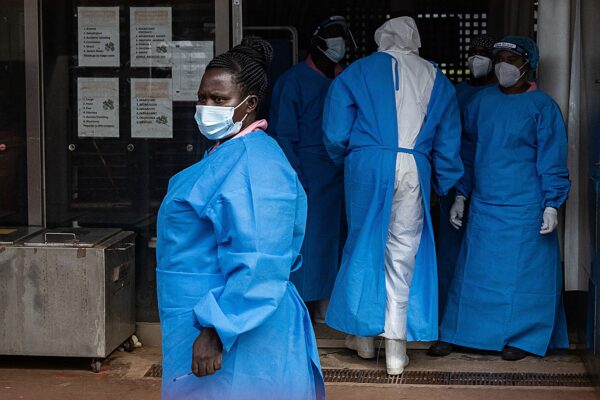
In the study, approximately 54 percent of the patients in the remdesivir treatment group died, while monoclonal antibodies against Ebola reported an overall mortality rate of 33.5 percent. One patient administered remdesivir experienced low blood pressure and subsequent cardiac arrest.
Remdesivir was shelved once again.
Later, the NIH funded a study of rhesus monkeys and found that when used prophylactically or in early treatment, remdesivir reduced the severity of disease, virus replication, and damage to the lungs when administered either before or after animals were infected with Middle East respiratory syndrome coronavirus (MERS-CoV).
Since the MERS virus is within the coronavirus family, researchers presumed that the drug’s benefits would apply to COVID-19, and the drug was trialed for COVID-19 patients.
Would Remdesivir Work for COVID-19?Mechanistically, remdesivir should have antiviral effects against COVID-19.
The drug can block the action of RNA-dependent RNA polymerase (RdRp), an enzyme present in all RNA viruses, including SARS-CoV-2.
As with all viruses, when the COVID-19 virus enters the cell, it needs to use the cell’s mechanism to create more of the virus. The SARS-CoV-2 virus replicates using its viral RNA stored in the center of the virus.
In an infection, the viral RNA will enter the human (host) cells and instruct the cells to produce more of the COVID-19 virus.
However, cells have their own “malware” program to prevent a viral attack.
Because viral RNA molecules differ from human RNA, the cell’s defense program can recognize that the instructions came from a virus and that there has been a firewall breach. The cell will then launch an attack.
RdRp changes the format of the instructions to pass scrutiny under this malware system. It does so by rewriting the instructions using the cell’s human RNA molecules. This way, the instructions look like they came from the cell.
This is where remdesivir comes in.
Remdesivir mimics human RNA molecules; it has been modified so that once it is added to the sequence, no additional human RNA molecules can be added.
Since no human RNA molecules can be added after remdesivir, the presence of remdesivir in any COVID-19 instruction creates an incomplete sequence and prevents the complete synthesis of the COVID-19 virus.
Most viral replication happens during the first week of infection when a person is asymptomatic or experiencing very mild flu-like symptoms.
A JAMA study published in January 2022 found that for people infected with the Wuhan strain, peak viral RNA levels would often coincide with when they first started showing symptoms. A review published in BMC Medicine found that the viral load in the upper respiratory tract declines after symptoms begin to appear; 17 studies and data from more than 2,000 COVID patients were evaluated for the review.
It appears, then, that remdesivir may have benefits if used in the early stages of the disease. Indeed, an Italian study found that, as an early treatment, it could reduce hospitalization and mortality.
However, remdesivir is administered mainly in hospitalized patients past the early stages of virus replication. Rather than the virus causing damage at this point, the body’s immune system is likely driving the damage and organ failure. This is why medical professionals question the use of remdesivir for hospitalized patients.
By the time patients are admitted to the hospital, they are likely suffering from the inflammatory symptoms caused by their immune systems against the virus and its particles; viral replication, judging by the declining viral load, would seem to be decreasing.
In January 2022, the Food and Drug Administration expanded remdesivir for non-hospitalized patients with mild to moderate COVID-19.
What Does the Data Show?There is no shortage of research into the efficacy of remdesivir.
The US Government Accountability Office reported that “[a]s of December 2020, federal funding for preclinical studies and clinical trials involving remdesivir totaled about $162 million.” That figure does not take into account studies conducted outside of the US.
The pivotal study used to propel the drug for emergency use authorization (EUA) is the Adaptive Covid-19 Treatment Trial (ACTT-1). It recruited 1,062 people and was sponsored by the NIH, with most of the authors receiving funding from Gilead.
In the study, half of the participants were given remdesivir for 10 days, and the other half were given a placebo.
At the outset, the study had a few questionable details, as the “placebo” given was not exactly a placebo.
A placebo is not supposed to bring about any change, harm, or benefit to the people taking it, as it is used as a baseline for safety.
“They gave what’s called an active comparator,” said Dr. Richard Amerling, who has over 40 years of experience in nephrology. “It has the same treatment protocol agents, except for a based substitute, an agent called sulfobutyl for remdesivir.”
Giving pharmaceutical agents would put the people taking the so-called placebo at risk of drug benefits and harm. If adverse events are reported in the placebo group, it may mask the harm of remdesivir, especially if the numbers between the two groups are similar.
In this study, 24.6 percent of the remdesivir group reported adverse events, which is lower than the 31.6 percent reported in the placebo group.
To demonstrate the drug’s benefits, before the study, the researchers set the primary endpoint as the drug’s ability to reduce mortality.
However, while there was less mortality experienced in the remdesivir group than in the control group, the participants in the remdesivir group were also less sick at the time of enrollment.
The study’s supplementary appendix showed that compared to the placebo groups, remdesivir groups had more participants who were less sick and fewer patients who suffered from severe disease.
For participants who did not need oxygen or needed only supplemental oxygen, the group that received remdesivir had a higher enrollment of 307 compared to 266 in the placebo group.
In severe patients who needed ventilation or high-flow oxygen, the group that received remdesivir had a lower enrollment of 226 compared to 252 in the placebo group.
In the middle of the study, the researchers changed the primary endpoint, which is uncommon and can compromise the validity of the study findings.
Nevertheless, the primary endpoint was changed to measure a decrease in the length of stay in the hospital.
“Our data show that remdesivir was superior to placebo in shortening the time to recovery in adults who were hospitalized with Covid-19 and had evidence of lower respiratory tract infection,” the authors wrote in the study’s conclusion.
However, the remdesivir group also had a higher readmission rate of 5 percent compared to 3 percent in the placebo group.
Other scientists have also picked up on the changed endpoint, finding the support for the use of remdesivir to be very weak, which is a significant concern.
Additionally, as with the studies on the COVID-19 vaccine, the placebo group at the end of the study was “unblinded.”
The placebo group was also given remdesivir at 10 days during the study because it was “an ethical obligation to immediately let the placebo group know so they can have access” to the drug.
This meant that researchers would no longer have a group they could follow to observe the long-term trends between the two groups because they eventually took the same drug.
These concerns raised regarding remdesivir’s pivotal trial cast doubt on the drug’s effectiveness.
“It’s just a fact that the best a drug is ever going to look is in the initial trial,” said Amerling, “and this was a trial done entirely by Gilead and [the NIH] and manipulated to the hilt to produce a fig leaf of a benefit.”
Before the publication of ACTT-1, two notable studies had found remdesivir to have no significant benefit in treating COVID-19 and advised against its use.
The first is a Chinese study of 233 patients, published in April 2020. It was a randomized, placebo-controlled, double-blind study, ticking all the boxes as an industry gold standard. Within the study, 155 were in the remdesivir group, and 78 were in the placebo group.
Patients were put on a 10-day treatment with remdesivir. The study had to be stopped early, as 12 percent of the remdesivir group reported adverse effects compared to five percent of the placebo patients.
The second was the SOLIDARITY study, funded by the World Health Organization (WHO).
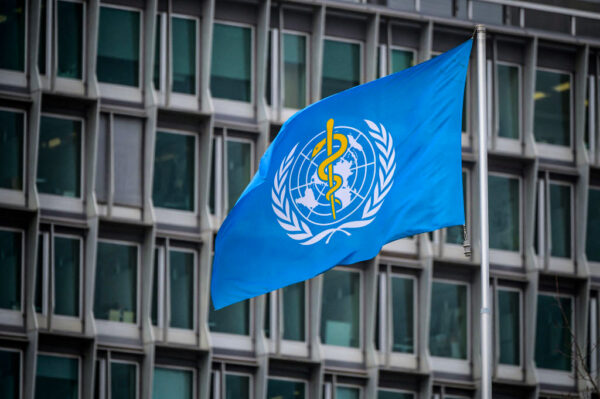
There were 11,330 people recruited for the study, with other drugs also tested. There were 2,750 subjects assigned to receive remdesivir, and the rest received other drugs, with no placebo for the study.
As with the Chinese study, the SOLIDARITY study found no reduction in mortality, ventilation, or hospital stay for any of the drugs investigated.
In an article in the journal Science, “The ‘very, very bad look’ of remdesivir, the first FDA-approved COVID-19 drug,” the author wrote that the WHO SOLIDARITY study was considered by some scientists a “coup de grâce” since this study showed remdesivir does not reduce mortality or the time COVID-19 patients take to recover.
Including Gilead’s pivotal trial and the two other studies mentioned above, at the time this article is published, at least 67 clinical or randomized controlled trials have been published on Pubmed on remdesivir use in COVID-19.
After excluding articles where the author’s opinion on remdesivir use or the significance of the remdesivir effect was unclear, only 24 articles remained for final evaluation.
Of the 24 articles, 13 were funded by Gilead or had authors who had financial ties with the company. The Epoch Times found that 11 of these articles reported clinical benefits of remdesivir or implied recommendation of remdesivir as a COVID-19 treatment, while two found no significant benefits in using remdesivir.
Of the other 11 articles that reported no financial ties with Gilead, five reported no significant benefit of remdesivir in clinical use. The remaining six recommended or found a clinical benefit of remdesivir use.
Despite releasing a statement in November 2020 recommending against the use of remdesivir, in April 2022, the health agency updated its statement, recommending the drug’s use in early COVID-19 patients
Side Effects and Safety ConcernsThe FDA’s product label for remdesivir (pdf) states that users should inform their health providers of underlying kidney and liver diseases.
The label also refers to kidney injuries observed in animal studies and reported in humans during studies.
Kidneys filter fluids to maintain the balance between water and salt concentrations. Kidneys also help to clear out toxins through the urine and are critical for the overall balance of the body.
Kidney failure can lead to fluid accumulation in the lungs and across all the different organs, leading to organ collapse and death. Researchers have found kidney injuries and failures to be a “severe adverse effect” of remdesivir use.
A study evaluating the FDA adverse event reporting system (FAERS) found that in 12,869 acute kidney injury cases in COVID-19 patients, almost a third of the reports were suspected to be driven by remdesivir. The authors also found that 36.45 percent of patients who experienced acute kidney injuries after remdesivir died.
“Although causality was not confirmed, the association between remdesivir and acute kidney injury should not be ignored,” the authors concluded.
A Dutch study on 103 COVID-19 patients treated with remdesivir found that 15 days after treatment initiation, 11 percent of the patients had a decrease in their estimated filtration rate, and 25 to 35 percent had markers that may be linked with liver dysfunction.
The relatives of many COVID-19 patients who witnessed their family member’s rapid decline reported that the worsening happened soon after remdesivir was administered. This included kidney injury, multi-organ failure, and even death.
Some people claimed that hospitals administered remdesivir even after family members insisted against it.
However, not all seem negatively affected by remdesivir; some have made a complete recovery following its administration.
Amerling said it is likely that some people are more susceptible to the adverse effects of remdesivir than others, and people with pre-existing kidney or liver problems were likely to be at a higher risk.
ReferencesGilead-funded or conducted by researchers with financial affiliation to Gilead:
https://www.ncbi.nlm.nih.gov/pmc/articles/PMC7262788/
https://www.ncbi.nlm.nih.gov/pmc/articles/PMC8757570/
https://www.ncbi.nlm.nih.gov/pmc/articles/PMC8863204/
https://www.ncbi.nlm.nih.gov/pmc/articles/PMC7454434/
https://www.ncbi.nlm.nih.gov/pmc/articles/PMC7212963/
https://www.ncbi.nlm.nih.gov/pmc/articles/PMC9334931/
https://www.ncbi.nlm.nih.gov/pmc/articles/PMC8499739/
https://www.ncbi.nlm.nih.gov/pmc/articles/PMC9477473/
https://www.ncbi.nlm.nih.gov/pmc/articles/PMC9270059/
https://www.ncbi.nlm.nih.gov/pmc/articles/PMC8523116/
https://www.ncbi.nlm.nih.gov/pmc/articles/PMC8490137/#CR17
https://www.ncbi.nlm.nih.gov/pmc/articles/PMC8439621/
https://jamanetwork.com/journals/jama/fullarticle/2769871
Studies reporting no financial affiliation with Gilead:
https://www.ncbi.nlm.nih.gov/pmc/articles/PMC8279143/
https://www.ncbi.nlm.nih.gov/pmc/articles/PMC7727327/
https://www.ncbi.nlm.nih.gov/pmc/articles/PMC7190303/
https://www.ncbi.nlm.nih.gov/pmc/articles/PMC8865433/
https://www.ncbi.nlm.nih.gov/pmc/articles/PMC8636497/
https://academic.oup.com/cid/article/75/1/e403/6515763
https://www.ncbi.nlm.nih.gov/pmc/articles/PMC8426890/
https://www.ncbi.nlm.nih.gov/pmc/articles/PMC9383489/
https://www.ncbi.nlm.nih.gov/pmc/articles/PMC8562044/
https://www.ncbi.nlm.nih.gov/pmc/articles/PMC9384598/
https://www.ncbi.nlm.nih.gov/pmc/articles/PMC9010446/
The Epoch Times seeks reporters in every U.S. state to cover state or regional news. Ideal candidates should be grounded in journalism ethics and dedicated to seeking the truth regardless of how it may contrast with personal bias or convictions.
To apply, send a cover letter, resume, and three samples of your news writing to [email protected]
Duties Find, pitch, and write state or regional news stories Cover breaking news events and scheduled events, including court cases, in related states or regions Follow major stories closely and be prepared to cover major and breaking developments Develop and maintain a pipeline of mid- and feature-length articles Build meaningful relationships with sources Travel to attend events and hearings, conduct on-the-ground reporting, and interview sources Adhere to the Society of Professional Journalists Code of Ethics and The Epoch Times reporting guidelines Work flexible days and hours that may include nights and weekends Skills Clear and concise AP-style news writing on a deadline Strong narrative skills for feature articles A proven ability to tell complicated stories in a thorough yet readable way Acumen for analyzing data, reports, and trends The ability to take well-composed still photos is a big plus Job Requirements Bachelors’ degree At least one year of experience as a professional reporter in related states or regionsWe are an equal opportunity employer and all qualified applicants will receive consideration for employment without regard to race, color, religion, sex, national origin, gender identity, disability, protected veteran status, or any other characteristic protected by law. We will consider for employment qualified applicants with criminal histories consistent with applicable law.
Investors have lost more than $7.6 trillion on U.S. stocks this year, and experts are warning that the losses could mount heading into 2023.
From institutional investors to retail traders, it’s been a challenging year to navigate the worst-performing market in five decades, Bespoke Investment Group says.
“It is no secret that 2022 has not exactly been the year of the 60/40 portfolio,” the group wrote in a research note in August, referring to a portfolio of 60 percent stocks and 40 percent bonds. “This year has left nothing safe with both stocks and bonds hit hard.”
The Nasdaq is parked in what Wall Street calls a bear market—when prices fall 20 percent or more—as the tech-heavy index is down nearly 30 percent year-to-date. The S&P 500 Index also fell into a bear market, sliding about 22 percent on the year. On Sept. 26, the Dow Jones Industrial Average, with a decline of 1.1 percent, became the last of the major U.S. stock indexes to fall into bear territory.
By comparison, when President Joe Biden took office in January 2021, the markets had rallied significantly from their bottom in March 2020, when COVID-19 was declared a pandemic. The Dow had climbed about 61 percent, the S&P 500 had rallied roughly 67 percent, and the Nasdaq spiked close to 97 percent in that span. These indexes then reached their peaks in late 2021.
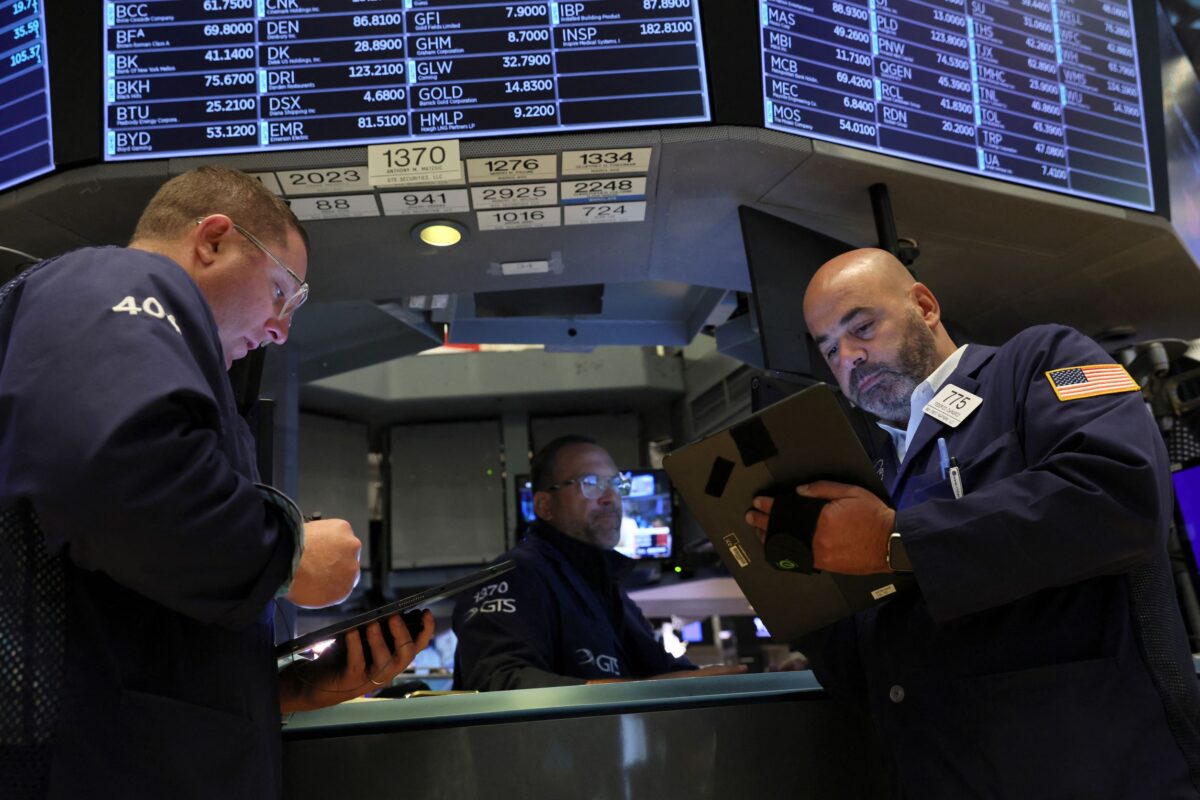
With the third quarter coming to an end, the Dow is poised for a 7 percent loss, while the S&P 500 and Nasdaq are each on track for a more than 6 percent drop.
What’s Driving the Markets?The three biggest drivers of this downward market have been surging inflation, aggressive monetary policy tightening by the Federal Reserve, and growing concern about global recession.
Despite the summertime rebound, market analysts say that the market bounce is over.
“There’s no reason this (stock) market can’t fall much further,” Richard Weiss, chief investment officer for multi-asset strategies at American Century Investments, told Morningstar. “If history is any guide, the market could easily go down another 10 percent to 20 percent.”
Ray Dalio, the billionaire founder of Bridgewater Associates, reiterated that position, suggesting higher rates could further sink equity prices.
“I estimate that a rise in rates from where they are to about 4.5 percent will produce about a 20 percent negative impact on equity prices (on average, though greater for longer duration assets and less for shorter duration ones) based on the present value discount effect and about a 10 percent negative impact from declining incomes,” he stated in a Sept. 13 LinkedIn post.
The Fed raised interest rates by 75 basis points during the September Federal Open Market Committee (FOMC) policy meeting, lifting the benchmark federal funds rate to a target range of 3 percent to 3.25 percent. According to a summary of economic projections by rate-setting committee members (pdf), interest rates could rise 4.4 percent by the end of this year and then to 4.6 percent in 2023, before easing to 3.9 percent in 2024 and 2.9 percent in 2025.
There had been some expectation that the central bank would pull the trigger on a full-point increase following a hotter-than-expected August inflation report. For now, Mimi Duff, the managing director at GenTrust, notes that investors are pricing in a peak federal funds rate of 4.6 percent around May 2023 as they digest the “higher for longer” messaging from the inflation-fighting Fed.
Instead of ultra-hawkish rate hikes, the Fed “is trying to look as tough as possible,” Christian Hoffman, a portfolio manager and managing director at Thornburg Investment Management, wrote in a note.
“I wouldn’t be surprised to see Chairman Powell enter the next meeting wearing a leather jacket and sporting a neck tattoo,” he wrote. “The Fed is willing to continue hiking through 2023 even if it means weaker growth and rising unemployment.”
Stocks in the 4th QuarterWhat does this mean for stocks in the final few months of 2022? It will be all about the data.
The FOMC’s economic projections show that officials think the unemployment rate will reach 4.4 percent next year, and that gross domestic product (GDP) will run at an anemic 1.2 percent pace in 2023.
Following two consecutive quarters of negative GDP growth rates, which indicates a technical recession, the U.S. economy risks running another quarter of subzero GDP.
The Federal Reserve Bank of Atlanta’s GDPNow estimate was slashed to 0.3 percent on Sept. 20, from a projected high of 2.6 percent on Sept. 1. Investors keep a close eye on the GDPNow model, which predicts GDP growth.
According to Deutsche Bank economists, investors will be paying attention to the final second-quarter GDP reading, the latest initial jobless claims, and the August personal income and spending data. They will be released later this week.
“In summary, Fed officials and market participants will get plenty of data to inform their views on the economic outlook. However, given the Fed’s recent rhetoric, much of it is likely to play second fiddle to the inflation data,” the financial institution explained in a note. “Continued upside surprises to inflation could lead to a peak fed funds rate exceeding 5 percent, particularly if it occurs in conjunction with easier financial conditions and a persistently tight labor market.
“Conversely, a faster decline in inflation coupled with tighter financial conditions and some loosening in the labor market, could beget a terminal rate closer to 4 percent. At this point, we see risks skewed in the hawkish direction.”
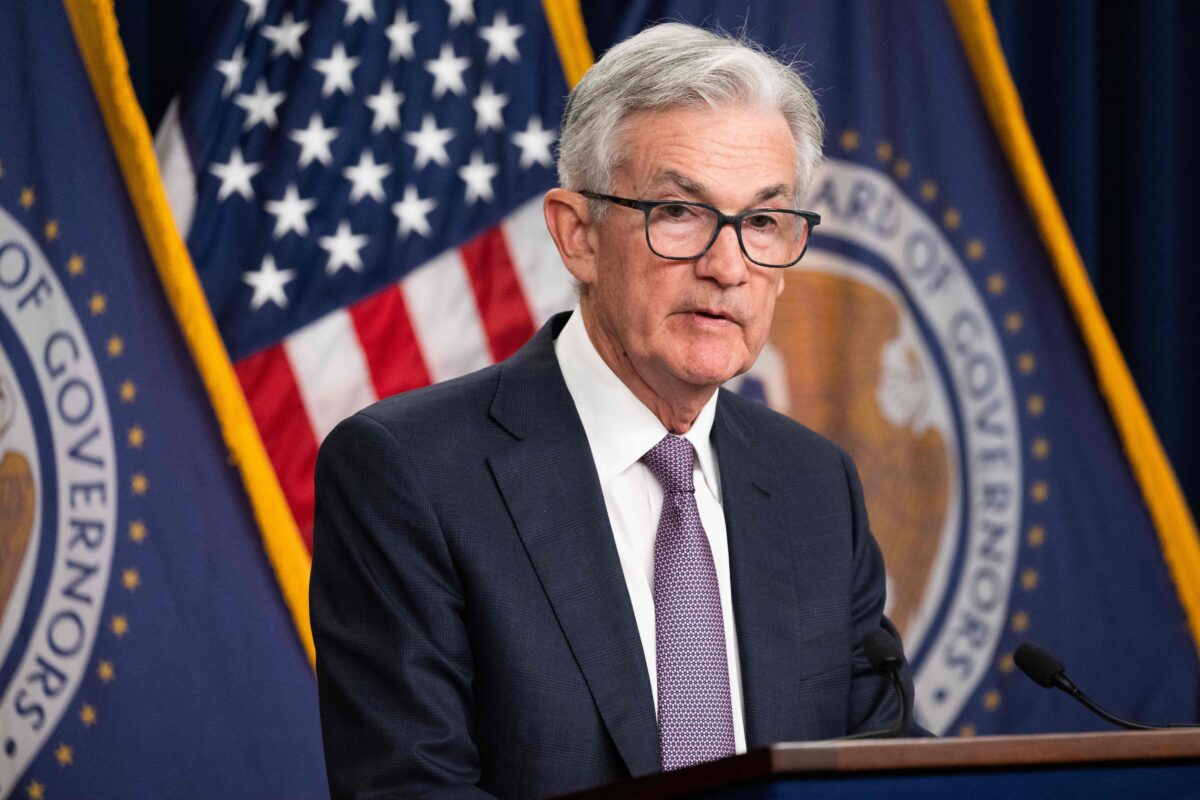
Both the Fed and the financial markets will be in “information-gathering mode at this point,” Duff noted.
“[The] Fed needs inflation lower and the jobs market closer to balanced,” Duff said. “A lot of wood to chop on both fronts, so we need to see how the real economy evolves.”
Looking ahead to the home stretch of 2022, stock market forecasts are mixed. Morgan Stanley’s Michael J. Wilson anticipates that “lows for this bear market will likely arrive in the fourth quarter.” The S&P 500 could slump an additional 13 percent to about 3,400 in the final three months of 2022, he told Bloomberg in an interview.
A Reuters poll of strategists in August revealed that the S&P 500 would end the year at 4,280. This would mean the broad measurement of stocks would need to rally about 16 percent in the final quarter.
Goldman Sachs slashed its new 2022 year-end S&P 500 target to 3,600 from 4,300, citing climbing interest rates.
In the end, “the soft-landing fairytale”—lowering inflation without causing economic pain—is “rapidly evaporating on Wall Street,” Scott Anderson, the chief economist at Bank of the West, said in a note.
“Global equity markets as you can imagine are not swallowing the Fed’s message well and equity analysts on the street are furiously cutting their year-end price targets. So now is a good time to keep your head down and take some shelter as the Fed is about to start breaking our finest china.”
Health Canada has approved a new COVID-19 vaccine from Moderna that targets both the original strain of the novel coronavirus and the Omicron variant.
The new shots approved by Health Canada, called bivalent vaccines, are designed to recognize specific mutations in the spike protein of the Omicron BA.1 subvariant.
In a decision posted on Health Canada’s website, the regulator says data show the new vaccine induces a similar immune response to the original strain of the COVID-19 virus and significantly higher responses to the Omicron BA.1 variant, when compared with the earlier version of the Moderna vaccine.
The United Kingdom approved Moderna’s new vaccine two weeks ago, and the United States Food and Drug Administration gave Moderna and Pfizer-BioNTech’s Omicron-fighting shots the green light earlier this week.
The version approved in the U.S. targets newer and more prevalent strains of the Omicron variant than the one submitted for approval in Canada.
Canada has already purchased 12 million doses of Moderna’s version of the Omicron vaccine, which includes converting some existing orders for the original Moderna vaccine so that the newly adapted version will be delivered instead.
By Laura Osman
Pennsylvania Lt. Gov. John Fetterman, the Democratic nominee in the state’s high-profile U.S. Senate contest, said Tuesday that he won’t debate Republican rival Mehmet Oz in early September as he recovers from a stroke in May.
According to a statement obtained by The Hill, Fetterman, who won the Democratic nomination while in the hospital, cited a statement made earlier on Tuesday by Oz’s campaign, which Fetterman described as making fun of his stroke.
The statement by Oz’s campaign outlined a list of concessions it’s willing to make to entice Fetterman to take part in a debate next week on KDKA-TV.
Oz’s campaign promised, in an apparently mocking tone, that the Republican candidate won’t “intentionally hurt John’s feelings” during the debate.
The Republican’s campaign also promised to allow the Democrat to “have all of his notes in front of him along with an earpiece so he can have the answers given to him by his staff, in real time.”
“At any point, John Fetterman can raise his hand and say ‘bathroom break!'” the statement continued. “If the topic of his pardoned murderers comes up, we will allow extra time for him to explain that second-degree murder is ‘not as bad as’ first-degree murder.”
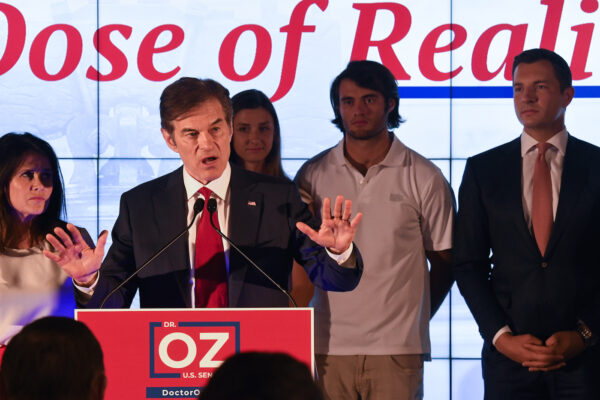
What Fetterman appeared to find particularly offensive was the final concession that Oz’s campaign was willing to “pay for any additional medical personnel he might need to have on standby.”
This, he said, made it “abundantly clear” that Oz and his campaign “think it is funny to mock a stroke survivor.” Fetterman said he won’t participate in the debate, describing it as a “farce.”
“I will not be participating in a debate the first week of September, but look forward to having a productive discussion about how we can move forward and have a real conversation on this once Dr. Oz and his team are ready to take this seriously,” Fetterman added.
Fetterman was admitted to hospital after suffering a stroke on May 13, just hours before he was scheduled to appear at a campaign event at Millersville University.
He underwent surgery in May to implant a pacemaker with a defibrillator to help him recover from his stroke, which he said was caused by a heart condition called atrial fibrillation.
The Democrat returned to the campaign trail in mid-August. The stroke has left him sometimes reaching for words, he has said in interviews, which could affect how he would perform in a debate.
Fetterman ‘Afraid’ to Debate OzEarlier on Tuesday, the Oz campaign’s communications director, Brittany Yanick, accused Fetterman of being a “lying liberal” who is afraid to face Oz in a debate.
“I mean, if I had to defend releasing convicted murderers and not paying my taxes 67 times, I’d be pretty worried too. I guess John Fetterman is afraid of debating Doctor Oz,” Yanick said.
Oz was endorsed by former President Donald Trump. The Pennsylvania political race is considered an important presidential battleground, with voters almost evenly split between Democrats and Republicans.
With the midterm campaign season about to kick into high gear, Oz has agreed to five televised debates hosted by local media affiliates in Pittsburgh, Greater Lehigh Valley, Philadelphia, and Harrisburg.
Fetterman’s spokesman, Joe Calvello, previously told The New York Times that Fetterman intended to debate Oz but didn’t commit to a specific number of debates.
The Epoch Times is seeking full-time and freelance journalists to cover news of national relevance in Canada.
The ideal candidate should be grounded in ethical journalism and able to balance the production of daily news, as well as develop enterprise stories and feature articles. You would be working remotely with an assignment editor.
Duties: Find and pitch local stories of national relevance Develop and maintain a pipeline of mid-length and longer articles Seek out primary sources and conduct original interviews When assigned, carry out reporting for national enterprise stories Adhere to the Journalism Code of Ethics and Epoch Times reporting guidelines Skills: Clear and concise writing on deadline, strong narrative skills for feature articles A proven ability to tell complicated stories in a thorough yet readable way Ability to take well-composed still photos a big plus Job Requirements: Bachelor’s degree Two years of experience as a professional reporterSend resume and sample work to [email protected]
As the federal government calls a public inquiry into the use of the Emergency Act, a diverse coalition of civil society groups is watching closely to ensure the investigation is broad in scope and independent.
Prime Minister Justin Trudeau invoked the Act for the first time since its creation on Feb. 14 in response to the Freedom Convoy protests, giving the federal government broad powers to deal with demonstrations against COVID-19 mandates in Ottawa and at some border crossings.
It was revoked on Feb. 23, after police cleared the protesters in the nation’s capital and a remaining border site was evacuated. By law, an inquiry into the use of the act must be called within 60 days of the declaration being cancelled, which lands on April 25.
“It really is a very bare-bones legal requirement,” Abby Deshman, the director of the criminal justice program with the Canadian Civil Liberties Association, told The Epoch Times.
“And in order for that to happen, an inquiry has to be independent, it has to be robust, it has to be comprehensive, and [have] a broad enough scope that it can actually review the surrounding context and beyond the government’s use of powers.”
Invocation of Act Under ScrutinyIn addition to the public inquiry and a separate special parliamentary committee, four groups and the province of Alberta have launched legal challenges to scrutinize the government’s use of the emergency law.

The CCLA and the Canadian Constitution Foundation (CCF) are among those with cases currently before the Federal Court.
In documents related to a court challenge filed by the CCF on April 22, Ottawa says it will not reveal evidence from closed-door cabinet meetings that led it to the use of the emergency law, according to a report from The Globe and Mail. The Trudeau government cited cabinet confidentiality powers given to ruling parties under the Canada Evidence Act in its response to the legal challenge.
Calgary-based CCF is asking the Federal Court to order cabinet to reveal the information to the judge and counsel involved.
The coalition of 15 civil society groups—which includes Amnesty International Canada, the Women’s Legal Education and Action Fund, National Council of Canadian Muslims, and Democracy Watch—are challenging Ottawa to release all requests for evidence within an independent inquiry.
They say it’s crucial the government allows opposition parties to select the commissioner or commissioners to assure the investigation is neutral.
The groups released a joint statement on April 13, arguing whoever leads the investigation should have all the powers of commissioners appointed under the federal Inquiries Act. That includes the ability to summon witnesses to give sworn testimonies in a court of record, and the requirement for witnesses to produce documents and written evidence.
“Let’s be crystal clear: an inquiry that does not include the sworn testimony of the major players involved and the production of documents is a sham,” Cara Zwibel, director of the fundamental freedoms program with the CCLA, said in a statement.
Canada’s Privy Council Office (PCO), which serves as the bureaucracy for the Prime Minister’s Office and co-ordinates government actions across departments, says an inquiry is set to be established by April 25.
“The report of the inquiry must be tabled in each House of Parliament within 360 days of the revocation of the emergency declaration,” a PCO spokesperson said in an emailed statement. “Further details will be announced in due course.”
‘Fatal Flaw’Under the Inquiries Act, the cabinet is allowed to select the commissioner of public inquiries—even if it’s an investigation is into actions of the ruling party.

Duff Conacher, co-founder of Democracy Watch, calls the provision of the law a “fatal flaw” that undermines Canada’s democratic process of holding the ruling party accountable.
“The government has all the incentive to choose some lapdog who’s not going do their job well, and let them off the hook in the end,” he told The Epoch Times. “It’s a major conflict of interest.”
Under Section 63 of the emergency law, Conacher says the government cannot limit the scope of the investigation for its use.
It’s “extremely important” to watch whether Trudeau hands over the power to opposition parties to select an inquiry commission, he says, because it was a political act to declare the emergency in the first place.
Since 2016, Democracy Watch has launched a number of legal challenges against the federal government, including two conflict of interest cases for its appointments of the ethics commissioner and the lobbying commissioner.
While the Federal Court of Appeal dismissed both cases, Conacher notes that it ruled the Trudeau cabinet was biased in each of its selections.
In a 2001 ruling, the Supreme Court of Canada set a precedent that all agencies, boards, commissions, and tribunals that enforce laws but are not courts, can be handpicked by the ruling party, even if there’s a conflict of interest.
“It’s a really bad ruling,” Conacher says. “It’s undermining the law enforcement across the country because it means that cabinets often choose loyal lapdogs to enforce key laws.”
Asking for an Independent ProcessSince it was announced, the CCLA and Democracy Watch has maintained their position that the federal government did not meet the legal threshold necessary to invoke the Emergencies Act. Premiers in Saskatchewan, Alberta, Manitoba, and Quebec also expressed concern over invoking the act, while some maritime premiers said it wasn’t needed.
The law defines a national emergency as an urgent situation that seriously endangers lives, health, or safety, and that cannot be effectively dealt with under any other law.

Deshman says the group has a tentative hearing date set for July for its Federal Court challenge. But she maintains the court case will remain a separate process from the public inquiry.
“The orders that the government passed raised significant constitutional issues and infringed on Canadian’s Charter rights in a way that was not justifiable,” she said. “But we’re not here to control the outcome of the inquiry. What we want is a truly independent process.”
The CCLA says the act allowed the Liberals to bypass regular democratic checks and balances to put in measures that weren’t rigorously debated by elected officials in parliament.
Deshman notes this led to a suspension of the Charter and constitutional rights of every Canadian, including significant limits on peaceful assembly. The act also handed police broad powers to end protests and empowered financial institutions to freeze bank accounts of individuals suspected of being involved in the protest without requiring a court order.
John Packer, a constitutional expert with the University of Ottawa Human Rights Research and Education Centre, says it’s good for Canadian society that civil rights groups want to hold the government to the highest standard in the courts by calling for a robust inquiry.
The 1988 Emergencies Act is not a piece of legislation to be “flippant” about, he says, because it involves the most serious of elements from a democratic point of view. And since the government almost immediately revoked the emergency law, Packer questions whether it had the merit in the first place to invoke it.
“We, as a society, better have pretty good clarity on this, because it also does set a precedent if it happens in another circumstance,” he told The Epoch Times. “We should all be immediately sitting up and on our toes whenever an emergency act is invoked.”
Packer says the emergency law was well drafted because of the protections in it, such as calling for an independent inquiry.
If the inquiry proves the government did not have reasonable grounds to invoke the law, there should be pretty severe consequences, Packer says, to prevent its misuse in the future.
It would also raise questions about whether our government understands our own democracy, which Packer adds is “pretty huge” if the people in charge don’t grasp the limits of their power.
“At the end of the day, what makes us a democracy is that our government is accountable to us, to you and me, to the people,” Packer said.
Trudeau cited “serious challenges to law enforcement’s ability to effectively enforce the law,” when he first announced its use.
“This is about keeping Canadians safe, protecting people’s jobs, and restoring confidence in our institutions,” he said.
According to Trudeau, the protests in Ottawa and at some border sites were illegal, dangerous, and a threat to the Canadian economy. He said the use of emergency legislation was necessary to give police the tools to restore order.

According to the court challenge filed by the CCF, the federal government intends to argue that the case is now moot, as the state of emergency has ended, and that the civil rights group lacks standing, or the right to bring the case.
House Committee ReviewIn March, the House of Commons formally selected a special joint committee to review the use of the Emergencies Act.
Made up of seven MPs and four senators, representing each of Parliament’s recognized parties and groups, it continues to review the exercising of powers given under the Act.
The committee—which is co-chaired by NDP MP Matthew Green, Bloc MP Rheal Fortin, and Independent Sen. Gwen Boniface—is set to meet on April 26. It has yet to release any findings.
Conservatives accused the government of ducking accountability by not including a member of the Official Opposition to co-chair the committee. Trudeau’s proposal for the committee’s makeup includes three Liberal MPs, and passed House by a vote of 214 to 115, with the support of NDP, Bloc Quebecois, and Green MPs.
Conservative House leader John Brassard said the Liberals, “backed by their NDP allies” were weakening the accountability and oversight measures written in the emergency proclamation.
“The Emergencies Act itself requires an opposition-heavy committee to review the use of those powers, because in a healthy democracy, the government of the day cannot be allowed to police itself,” he said in a statement.
Today many are hearing the phrase “trust the science” more than ever before. In response to the current cultural narrative, EpochTV is leading the effort to provide resources and education on real science, not secular propaganda. As part of this initiative, EpochTV is proud to announce their partnership with Awesome Science Media (ASM), a company dedicated to producing high-quality DVD programming which focuses on presenting a Biblical worldview on topics of historical and operational science. ASM programming is geared to all ages and represents documentaries, children’s shows, action-adventure shows, and reality programming.
About Awesome Science Media
ASM is a family-operated company, and a division of Compel Media, LLC. Compel Media is owned by Kyle Justice, an Emmy-nominated veteran television producer whose clients include networks like ESPN, National Geographic, and The Outdoor Channel.
ASM’s mission is to proclaim the awesome works of God and make Him known among the nations by producing and distributing high-quality documentaries and children’s programming which present a Biblical worldview to science.
How They Serve You
ASM programming is the perfect fit for school-age children and homeschool families looking for Biblical educational resources, Churches seeking to provide biblical teaching to their congregations, along with anyone else wanting to expand their knowledge on these important issues.
ASM programming first began with the Awesome Science and Flood Geology DVD series. Now, they have expanded to other series such as The Heavens Declare, Dino Hunter, Creeping Things, Debunking Evolution, Ocean Odyssey, and The Top Ten.
ASM is continually developing new programming series for their global audience, such as Awesome Science Applied, Ark Animals, Ancient Man, The Inside World, and Awesome Creatures. They also offer a worldwide Subscriber Video On Demand platform called AwesomeSciTV. All new content that ASM produces is accessible on their On Demand platform for one low monthly fee, in addition to providing a 7-day free trial.
Program Sneak Peeks
Dino Hunter Series – 3 Episodes
Dino Hunter is hosted by Emmy award-winning host, Jeremy McLaughlin. This new series explores the mysteries of dinosaurs, how they fit into the Biblical record, how the Flood greatly impacted their future, evidence of dinosaurs after the Flood, as well as presenting evidence to confront claims by secular paleontologists that dinosaurs lived millions of years ago. Jeremy will travel the world to explore dinosaur sites and interview the experts in paleontology who hold to a biblical worldview.
The Heavens Declare Series – 21 Episodes
In this series, leading creation science astronomers, physicists, and cosmologists are interviewed to share evidence for a young universe as described in the Bible. They will address many of the supposed “evidences” for a universe that is billions of years old and why this theory is simply not valid. Experts include Dr. Danny Faulkner, Dr. Jason Lisle, Dr. Don DeYoung, Dr. Russ Humphreys, and Spike Psarris.
Science Foundations – 14 Episodes
Join science teacher Joel Thomas as he presents lab experiments for kids on various science topics, all from a Biblical Worldview.
Check out ASM resources and videos here on EpochTV!
Buying the DVD: awesomescitv.com/epochtv
Follow EpochTV on social media:
Facebook: https://www.facebook.com/EpochTVus
Twitter: https://twitter.com/EpochTVus
A two-minute silence has been held by a community mourning the loss of their MP Sir David Amess, who was killed a week ago.
Sir David, 69, was stabbed to death shortly after midday while carrying out duties in his Southend West constituency.
Local shopkeepers and residents in Eastwood Road North, Leigh-on-Sea, bowed their heads and stood in a hushed silence which was broken with applause and the release of blue balloons in respect to the veteran politician.

With many in the community still in shock at the killing, James Duddridge, the MP for Rochford and Southend East, said, “It is going to be very difficult not just for the family but for the whole community.”
He said that time may be needed to help everyone deal with the tragedy and recalled Labour MP Jo Cox, who was killed outside her constituency surgery in Birstall, near Leeds, in June 2016.
After the silence in honour of Amess, Duddridge told mourners: “Speaking to Jo Cox’s family, it took them a long time to recover and we must spend time together as a community and not be afraid to cry and share a cuddle, share a story, to share a funny story as well as a sensible story.
“I think that is one of the things that the Cox family said was really important—to remember a person and spend time together as a community.
“Please feel free to stay, talk, and share your stories with me, the clergy, the mayor, and the local councillors, with friends and family, so that we can try to make sense of what has happened and, in some small way, maybe bring something good out of this.”
Last week, the Queen agreed that Southend will be upgraded to city status—something Amess had pushed for over two decades.
Duddridge said: “Everyone is pleased that we got city status—let’s make something of that and in David’s memory carry on the campaigns, but also to do it in our own way and be civic activists and come together.”
The tribute took place near the Woodcutters Arms pub, a short distance from Belfairs Methodist Church where Amess was attacked.

Father Jeffrey Woolnough had rushed to the church when he heard that Amess, a devout Catholic, had been stabbed in the hope of giving him the last rites.
He was unable to deliver the sacrament as the area had become a crime scene.
Woolnough, who was among those gathered for the silence, said, “He has an incredible gift that he is passing on to us now from his place with the Lord.
“There was a great spirit of reaching out to everyone. He actually enjoyed his work and that is why it is very difficult to find a picture of him online where he is not smiling.
“All of that is infectious, that breaks down barriers.”
He said he spoke to people from all parties, races, and religions, and “it was such a great gift and it was tireless because it was sincere.”
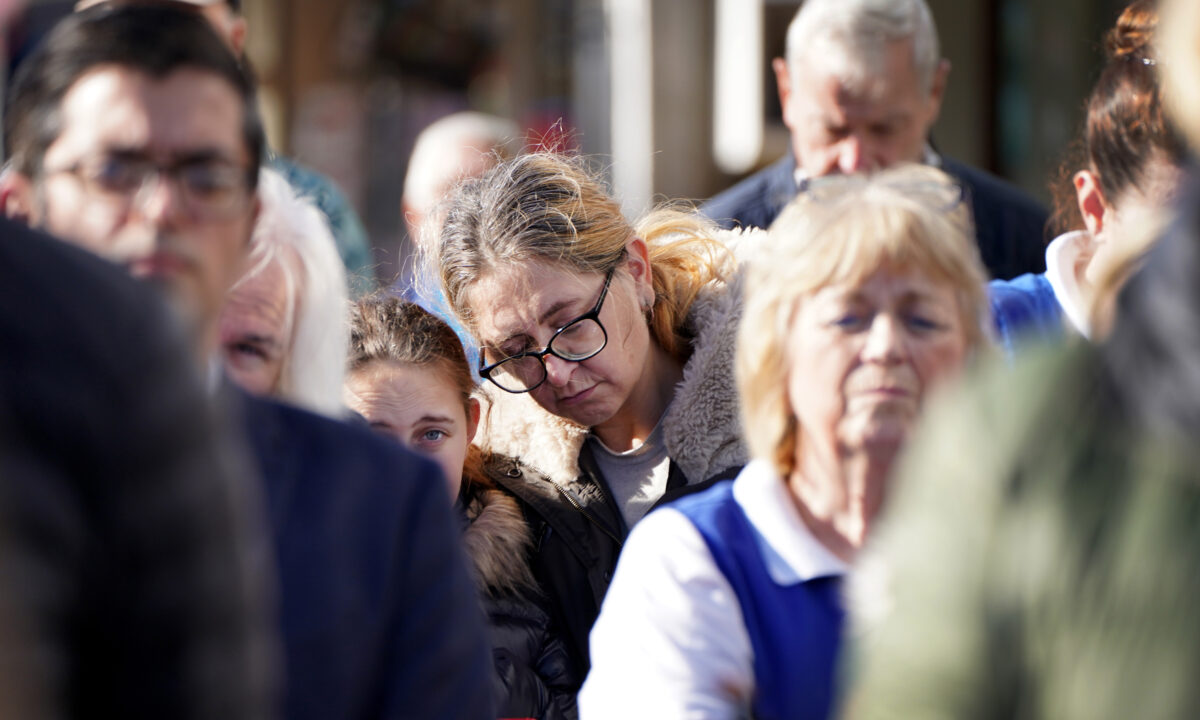
Dental hygienist Luke Snelling, who stepped away from his work at the local dentist to take part in the tribute, said Amess’s death had “really started to kick in” because “he was such a local figure and this was an awful attack on a really nice human being.”
“This is quite a quiet area. I have been quite impressed with how people have rallied around each other in the community,” he said.
“I think he would have loved to have seen that spirit, especially as it is his constituents who are trying to help each other out.”
Butcher Tony Phillips, who closed up his shop for the tribute, said: “We are all just so very sad that he is no longer with us.
“We used to see him quite regularly. He used to come into the shop every now and then to see if we had any problems. He will be sadly missed.
“I think that everybody is down at the moment and people are still in shock.”
Estate agent Rob Cooke said: “Sir David was very much part of the community and obviously we are just gutted with what has happened. I just wanted to pay my respects and to think about him and his family.
“I think it is going to take quite a long time for the community to recover from what has happened.
“I think it has left a hell of a lot of people in shock.
His colleague John Russell added: “I think the nice thing about him was that he was very genuine and a real people person.
“He was always very good at talking to people and remembering names.
“He was very good in the community. You would always see him at schools, churches, and things that was [sic] happening. It all still hurts.”
The church where the attack happened is to remain closed for two weeks, an announcement on its website said.
Floral tributes to Amess which had piled up outside the church hall have since been moved to his constituency office, Iveagh Hall.
The Epoch Times is seeking full-time and freelance journalists to cover news of national relevance in Canada.
The ideal candidate should be grounded in ethical journalism and able to balance the production of daily news, as well as develop enterprise stories and feature articles. You would be working remotely with an assignment editor.
Duties: Find and pitch local stories of national relevance Develop and maintain a pipeline of mid-length and longer articles Seek out primary sources and conduct original interviews When assigned, carry out reporting for national enterprise stories Adhere to the Journalism Code of Ethics and The Epoch Times reporting guidelines Skills: Clear and concise writing on deadline, strong narrative skills for feature articles A proven ability to tell complicated stories in a thorough yet readable way Ability to take well-composed still photos a big plus Job Requirements: Bachelor’s degree Two years of experience as a professional reporterSend resume and cover letter to [email protected]
The Epoch Times iOS app as of Nov. 12 is the No. 1 app in the Magazine & Newspaper category in the Apple store. We would like to thank all of our readers for making this possible.
Readers deserve and demand factual and unbiased reporting, and we would like to say that we hear you clearly.
Many media organizations have failed the public for too long. While other media were quick to call the election, The Epoch Times, as an independent media outlet, has stated it will not declare a winner until all results are certified and any legal challenges are resolved.

Our principles of factual and unbiased reporting are in our DNA. Since our organization was founded in the United States by Chinese-Americans, The Epoch Times has been exposing the Chinese regime’s persecution of the Chinese people, rejecting the Chinese Communist Party’s agenda, and exposing its infiltration of the United States.
We have been covering President Donald Trump factually and without bias from the day he announced his presidential bid, while some mainstream media have shown bias against him. We apply the same principles to any candidate running for public office, regardless of party.
Pursuing the truth is never an easy task.
In America, our advertisers have been threatened by Chinese consular officials and our newspaper boxes have been vandalized. In Hong Kong, one of our printing presses was set on fire. Recently, attacks have come from our peers—other U.S. media organizations that don’t agree with our reporting.
However, we know you—our readers—are always at our side; our app downloads are soaring and the amount of positive feedback we’re receiving is overwhelming. The Epoch Times app so far has over 1 million downloads on the iOS and Android app stores combined, and it’s one of the highest-rated apps.
However, the mission of restoring public confidence in journalism is far from complete.
We will continue our factual and unbiased reporting and seek to uphold the highest standards of traditional journalism.
Correction: A previous version of this article misstated the factors that affect app rankings on the Apple App store. The factors include the number of downloads, user experience, user ratings, and the overall performance of the app. The Epoch Times regrets the error.
WestJet says it will provide refunds for flights the company cancelled due to the COVID-19 pandemic.
The airline said on Oct. 21 that it will start to contact eligible travellers to offer refunds via email on Nov. 2. WestJet said eligible travellers include returning Canadian citizens, permanent residents, or foreign nationals currently permitted entry into Canada.
The company will offer refunds in the original form of payment. Refunds are also offered for basic fare tickets.
WestJet said the refund process is estimated to take six to nine months due to “administrative backlogs.” Customers are asked to wait until they are contacted, so as not to overload the contact centre.
President and CEO Ed Sims said airlines around the world has been heavily struck financially by the pandemic, and WestJet is doing what it can to reduce costs in its operations after flight demands took a 95 percent freefall.
“We went 72 days in a row where cancellations outstripped bookings, something that has not happened—ever—in our almost 25-year history,” Sims said in a press release.
“Thankfully, we are seeing bookings higher than cancellations now but still at a level that sees more than 140 of the 181 aircraft in our fleet parked and more than 4,000 WestJetters permanently laid off.”
Sims said the company is the first national airline in Canada to offer refunds proactively, but that was refuted by Air Canada on Twitter.
“Misleading statement! WestJet is just now catching up to our policy to refund refundable fares. We have already refunded over $1.2 Billion in refundable fares to date,” the tweet said.
Air Canada has reimbursed refundable tickets and has offered vouchers for the non-refundable tickets, according to CBC News.
However, Air Canada has received 1,705 complaints over refunds, the highest among non-U.S. airlines, according to the U.S. Air Travel Consumer Report released in August. WestJet had received 346 refund complaints.
Border restrictions on non-essential travel between Canada and the United States have been prolonged for another month, Canada’s Public Safety Minister Bill Blair said in an announcement on Twitter Oct. 19.
Blair said the decision was “based on the best public health advice available to keep Canadians safe.” The move delays non-essential travel from the United Sates until November 21, unless the restrictions are again extended.
Since the Canada-U.S. border shutdown in March, the agreement has been extended several times, with the current one scheduled to expire on October 21st. The repeated extension was made because “United States is not in a place where we would feel comfortable reopening those borders,” said Prime Minister Justin Trudeau in an interview on October 14th.
Under current restrictions, people who are not Canadian citizens or permanent residents cannot enter the country for tourism, recreational, or other optional purposes. Those who are allowed to enter must quarantine for 14 days. Failure to comply with border restrictions can result in a maximum $750,000 fine or six months imprisonment.
Blair announced earlier in the month that travelers with “compassionate reasons” can be admitted starting on October 8th. This adjustment allowed Canadians citizens and permanent residents to reunite with their extended family members and those they share a dating relationship with that has lasted for at least one year.
I want to thank you for being our loyal reader—we couldn’t do what we do without your support.
Reporting the facts as an independent media is not always easy. Over the past 20 years, our advertisers have been threatened by Chinese embassy officials in the United States, our newspaper boxes have been vandalized, and last year one of our printing presses in Hong Kong was set on fire.
And because of our investigative reporting on the Chinese Communist Party (CCP), as well as our nonpartisan reporting on U.S. politics, other media in the United States have tried to smear us. As a result, we have lost some advertisers as well as our ability to advertise on Facebook.
But this adversity has also made us more determined to keep providing you, our readers, with the best independent news. We understand that now, independent news and information is more important than ever.
In our efforts to continue and develop our independent reporting, we have launched a digital subscription.
Aside from full access to our app, a digital subscription will make you a premium member of The Epoch Times and give you unlimited access to all of our content, including premium content such as exclusive videos, infographics, investigative reports, and e-magazines on our website.
For more information, refer to our app.
Jasper Fakkert
Editor-in-chief, U.S. editions
Dear Epoch Times Readers,
We are happy to announce that we are launching the beta version of MyForum as a platform for our readers to stay up to date and openly discuss current events. As this is the beta version of the forum, we welcome and encourage you to send your feedback to [email protected] so we can further improve this platform to better serve you.
The forum is part of The Epoch Times’ website, hence you can automatically use it as long as you are already logged into The Epoch Times’ website.Thank you for being our loyal readers. We look forward to hearing from you!
The Epoch Times Web Team